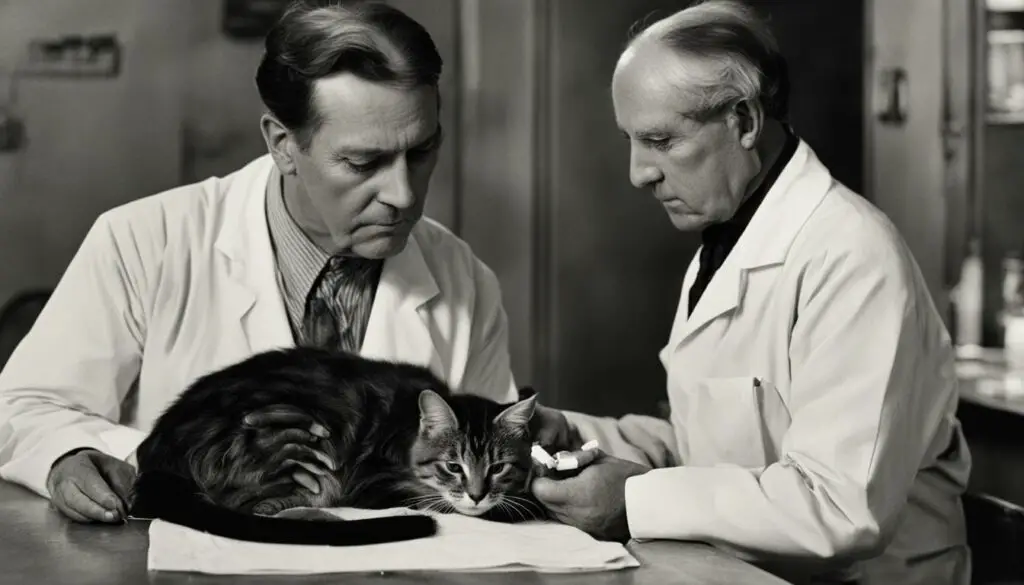Cats are often euthanized or relinquished and subsequently euthanized because they urinate outside of the litter box. However, it’s important to understand that urinating outside the litter box is a treatable problem with a positive outcome. Cats don’t urinate on the bed out of spite or hatred. There are two broad categories of inappropriate urination: urine marking and toileting. Cats may abandon the litter box due to social stress, environmental stress, medical illnesses, or anxiety/fear. It’s crucial to seek veterinary help to address the problem and explore treatment options.
Key Takeaways:
- Urinating outside the litter box is a treatable problem with a positive outcome.
- There are two broad categories of inappropriate urination: urine marking and toileting.
- Cats may abandon the litter box due to social stress, environmental stress, medical illnesses, or anxiety/fear.
- It’s crucial to seek veterinary help to address the problem and explore treatment options.
- Euthanasia should only be considered after exhausting all treatment options and evaluating the cat’s quality of life.
Why Do Cats Urinate Outside of the Litter Box?
Dealing with a cat’s urination problem can be frustrating, but it’s important to understand why cats exhibit this behavior. Contrary to popular belief, cats do not urinate outside the litter box out of spite or a desire to hurt their owners. There are several common reasons why cats may urinate outside of the litter box:
- Social stressors: Introducing new people or pets into the household can cause a cat to feel anxious or threatened, leading to urination outside of the litter box.
- Environmental stressors: Inadequate or dirty litter boxes, as well as changes in the physical environment, can make a cat uncomfortable and cause them to seek alternative places to urinate.
- Medical illnesses: Cats with kidney disease, urinary tract infections, or other medical conditions may experience discomfort or pain while using the litter box, prompting them to urinate elsewhere.
- Anxiety or fear: Some cats may develop anxiety or fear associated with the litter box, often due to previous negative experiences or traumatic events. This can lead to avoidance of the litter box and urination outside of it.
Identifying the underlying cause of the behavior is crucial in addressing the problem effectively. It is recommended to consult with a veterinarian to rule out any underlying medical conditions and to explore possible treatment options.
| Common Causes of Urination Outside of the Litter Box | Examples |
|---|---|
| Social stressors | New addition to the family |
| Environmental stressors | Dirty litter box |
| Medical illnesses | Urinary tract infection |
| Anxiety or fear | Past traumatic experience |
“Cats do not urinate outside the litter box out of spite or a desire to hurt their owners.” – Unknown
Understanding the reasons behind a cat’s urination problem is the first step toward finding a solution. By addressing the underlying cause, providing a supportive environment, and seeking professional guidance, you can help your cat regain proper litter box habits and improve their overall well-being.

How to Address the Problem
When faced with a cat’s urination problem, it’s important to take proactive steps in addressing the issue. There are several humane ways you can handle this problem and improve your cat’s litter box habits. By implementing the following strategies, you can help your cat and create a more harmonious living environment.
1. Increase the number of litter boxes:
Cats prefer to have options when it comes to their bathroom needs. If you have multiple cats in your household, it’s essential to provide an adequate number of litter boxes. The general rule of thumb is to have one litter box per cat plus an additional one. This ensures that each cat has their own space and reduces the likelihood of territorial disputes or litter box aversion.
2. Clean the litter box regularly:
Regular cleaning of the litter box is crucial for maintaining your cat’s hygiene and encouraging them to use it consistently. Scoop the litter box at least once a day to remove soiled litter and waste. Additionally, replace the litter completely on a weekly basis to ensure cleanliness and freshness.
3. Ensure the litter box is appropriately sized:
Make sure that the litter box is large enough for your cat to comfortably enter and move around in. Cats prefer an open space where they can easily turn around and dig. If the litter box is too small, it may discourage your cat from using it, leading to inappropriate urination elsewhere.
4. Spread litter boxes throughout the house:
Placing litter boxes in different areas of your home can help cater to your cat’s preferences and provide easy access. This is especially important in multi-level homes or larger living spaces. Having litter boxes readily available throughout the house reduces the likelihood of your cat searching for alternative places to relieve themselves.
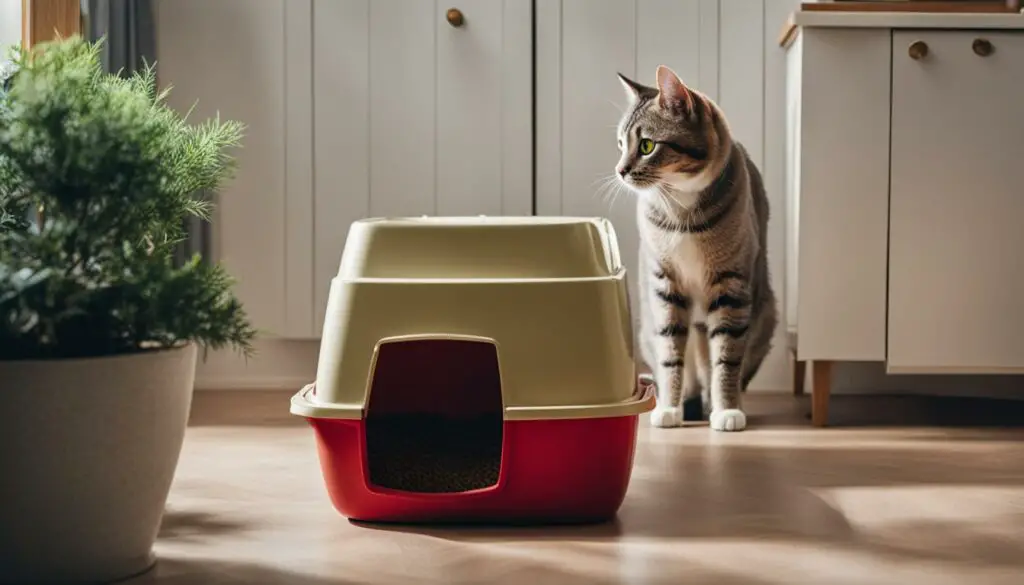
| Benefits of Humane Approaches | Benefits of Punitive Approaches |
|---|---|
|
|
By implementing these humane strategies, you can create a supportive environment for your cat and help them overcome their urination problem. Remember to always consult with a veterinarian for professional guidance and advice tailored to your cat’s specific needs.
The Importance of Medical Evaluation
When a cat is experiencing urination issues, it is crucial to seek a thorough veterinary evaluation. Many medical conditions can influence a cat’s urination behavior, and identifying them is essential in developing an effective treatment plan. Some common medical conditions that can contribute to urination problems in cats include:
- Kidney disease
- Urinary tract infections
- Bladder stones
- Diabetes
- Hyperthyroidism
These conditions can significantly impact a cat’s urination habits and may require specific medical interventions or management strategies. Conducting a medical evaluation will help rule out or diagnose any underlying medical issues, ensuring that the appropriate treatment can be implemented to address the urination problem effectively.
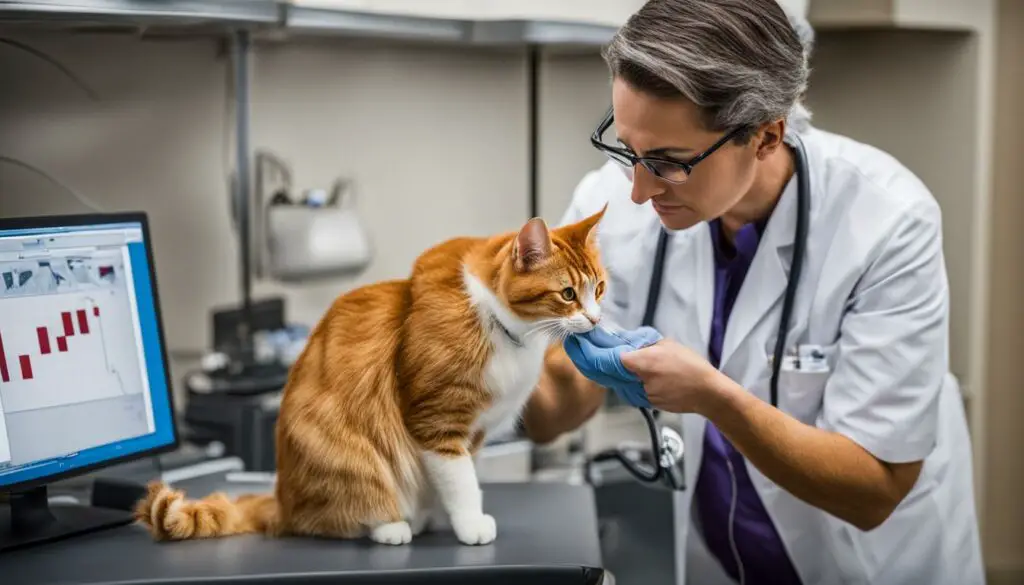
Table: Medical Conditions Influencing Cat’s Urination Behavior
| Medical Condition | Symptoms | Treatment |
|---|---|---|
| Kidney Disease | Increased thirst, frequent urination, weight loss, lethargy | Fluid therapy, dietary management, medication |
| Urinary Tract Infections | Straining to urinate, blood in urine, frequent urination | Antibiotics, urinary acidifiers, increased water intake |
| Bladder Stones | Straining to urinate, blood in urine, frequent urination | Surgery, dietary management, medication |
| Diabetes | Increased thirst, increased urination, weight loss, lethargy | Insulin therapy, dietary management |
| Hyperthyroidism | Increased appetite, weight loss, increased thirst, increased urination | Medication, dietary management, radioactive iodine therapy |
By addressing these medical conditions promptly, cat owners can improve their pet’s quality of life and prevent unnecessary suffering. Veterinary guidance is crucial in diagnosing and managing these conditions, ensuring the best possible outcome for the cat.
Factors to Consider Before Euthanasia
Deciding to euthanize a cat for urinating is a sensitive decision that requires careful consideration. Before making this choice, it is important to take into account several factors that can influence the decision-making process:
- The severity and duration of the urination problem: Assess how long the issue has been going on and the impact it has on the cat’s daily life.
- The cat’s response to treatment: Evaluate the effectiveness of the treatment options that have been tried and consider if there are any alternative treatments available.
- The impact on the cat’s overall well-being: Consider the physical and emotional toll the urination problem has on the cat, as well as its overall quality of life.
- The emotional and financial resources available: Consider the emotional capacity and financial resources you have to address the problem. Euthanasia should not be the first option, so explore the available support and alternatives.
It is important to remember that euthanasia should only be considered after all treatment options have been exhausted and the cat’s welfare has been thoroughly evaluated. Seek guidance from your veterinarian, who can provide valuable insight and support during this difficult decision-making process.
Remember that you are not alone
Making the decision to euthanize a beloved pet is never easy, and it is normal to experience a wide range of emotions. Reach out to friends, family, or support groups who can provide understanding and empathy during this challenging time. Remember that you are not alone, and there are resources available to help you through the process.

| Factors to Consider Before Euthanasia |
|---|
| Severity and duration of the urination problem |
| The cat’s response to treatment |
| Impact on the cat’s overall well-being |
| Emotional and financial resources available |
Understanding the Euthanasia Process
When it comes to the euthanasia process for cats, it’s important to know what to expect and how to make the experience as comfortable as possible for both the cat and yourself. Euthanasia involves administering a euthanasia solution, usually a barbiturate, to induce loss of consciousness, pain sensation, and eventually stop the heart and lungs. It is a quick and painless process for the cat.
Whether or not to be present during the euthanasia is a personal decision that depends on what you feel would be most comforting for both you and your pet. Some owners find comfort in being present, offering reassurance and support to their beloved cat during their final moments. Others may find it too emotionally difficult and choose not to be present. There is no right or wrong choice, and it’s important to do what feels right for you.

The Procedure of Euthanizing a Cat
The euthanasia procedure typically involves the following steps:
- Preparing the cat: The veterinarian will ensure that the cat is comfortable and administer any necessary sedation to reduce anxiety and stress.
- Administering the euthanasia solution: The veterinarian will inject the euthanasia solution, typically into a vein, to allow for a rapid and peaceful passing.
- Monitoring the process: The veterinarian will monitor the cat’s vital signs to ensure a humane and painless procedure.
- Offering support: Throughout the process, the veterinarian and their team will provide support and compassion to both the cat and the owner.
Remember, the decision to be present or not during the euthanasia process is deeply personal, and there is no right or wrong choice. What matters most is that you feel comfortable and at peace with your decision.
Support and Comfort for the Owner
In the difficult decision of euthanizing a beloved pet, emotional support for the owner is essential. Veterinarians understand the profound bond between a pet and their owner and strive to provide empathy, compassion, and comfort during this challenging time. Many veterinarians allow owners to be present during the euthanasia process, creating a peaceful and serene environment where both the pet and the owner can find solace.
Being present during euthanasia can offer a sense of closure and provide an opportunity for final goodbyes. It allows the owner to be with their pet in their final moments, offering comfort and support. This process can be deeply meaningful and help facilitate the grieving process, knowing that their beloved companion was surrounded by love and care until the end.
Alongside allowing owners to be present, veterinarians also offer emotional support through open and honest communication. They understand the intense emotions that come with saying goodbye to a cherished pet, and they provide guidance, empathy, and a shoulder to lean on. Whether it’s explaining the euthanasia process, answering questions, or simply offering a listening ear, veterinarians strive to provide a safe space for owners to express their emotions and find comfort.

Grief is a natural response to losing a beloved pet, and it is important to give yourself permission to mourn. Reach out to friends, family, or support groups who can provide understanding and empathy during this difficult time. Share your feelings, memories, and stories about your pet, allowing yourself to process the loss and find healing.
Remember that everyone grieves differently, and it’s okay to seek professional help if needed. Grief counseling or therapy can provide additional support and guidance as you navigate the complex emotions that come with losing a cherished companion. This process takes time, and it’s important to be patient and kind to yourself as you heal.
Aftercare Options
After the euthanasia procedure, there are several aftercare options for your beloved cat. It’s important to choose an option that aligns with your personal preferences and respects your cat’s memory. Here are some common aftercare options:
- Private cremation: With private cremation, your cat is cremated individually, and you have the option to receive their ashes in a decorative urn or keepsake.
- Burial: If you prefer, you can choose to bury your cat in a pet cemetery or on your own property. It’s important to consider local regulations and guidelines when opting for burial.
- Communal cremation: In communal cremation, multiple pets are cremated together, and the ashes are not returned to the owner. This option provides a respectful and communal farewell.
- Veterinary disposal: You may choose to leave your cat’s remains with the veterinarian for appropriate disposal. This option ensures proper and respectful handling of your cat’s remains.
It’s crucial to discuss these aftercare options with your veterinarian, as they can guide you through the process and provide you with the necessary information to make an informed decision that best suits your needs.

Example of Aftercare Options
| Aftercare Option | Description |
|---|---|
| Private Cremation | Individual cremation with the option to receive your cat’s ashes in a decorative urn or keepsake. |
| Burial | Burying your cat in a pet cemetery or on your own property, following local regulations and guidelines. |
| Communal Cremation | Multiple pets are cremated together, and the ashes are not returned to the owner. |
| Veterinary Disposal | Leaving your cat’s remains with the veterinarian for appropriate disposal. |
Coping with Grief and Loss
When we face the loss of a beloved cat, the pain can be overwhelming. It’s important to give ourselves time to grieve and process our emotions. Remember that everyone copes with loss differently, and there is no right or wrong way to mourn the loss of a cherished companion.
During this difficult time, it can be helpful to reach out for support from friends, family, or support groups who understand the unique bond we share with our pets. Talking about our feelings and memories can provide comfort and solace. If needed, don’t hesitate to seek professional help from a therapist who specializes in grief counseling.
Creating a memorial or tribute to honor our cat’s memory can also be a healing process. Consider planting a tree or flowers in their memory, creating a photo album or scrapbook, or donating to a charity in their name. These acts of remembrance can help us cherish the happy moments we shared with our beloved companion.
“Grief is the price we pay for love.” – Queen Elizabeth II
Take your time to heal and remember that it’s okay to feel a range of emotions, from sadness and anger to guilt and confusion. Our cats bring so much love and joy into our lives, and it’s natural to feel a deep sense of loss when they are no longer with us. Be patient with yourself, and remember that with time, the pain will lessen, and the happy memories will shine through.
| Supportive Tips | Letting Go |
|---|---|
| Reach out for support from friends, family, or support groups. | Allow yourself to feel a range of emotions. |
| Create a memorial or tribute to honor your cat’s memory. | Be patient with yourself and give yourself time to heal. |
| Consider seeking professional help from a grief counselor. | Know that the pain will lessen with time. |

Seeking Professional Guidance
If you’re struggling with your cat’s urination problem or facing the decision of euthanasia, it’s important to seek professional guidance. Veterinarians and board-certified veterinary behaviorists are highly trained experts who can provide valuable advice, develop tailored treatment plans, and offer support throughout the process. Their expertise and empathy can make a significant difference in finding a compassionate and appropriate solution for your cat.
Consulting a veterinarian is the first step in addressing your cat’s urination issue. They can conduct a thorough examination, perform necessary tests, and rule out any underlying medical conditions that may be contributing to the problem. A veterinarian can offer guidance on behavior modification techniques, prescribe medications if necessary, and help you navigate the treatment process.
In some cases, consulting a board-certified veterinary behaviorist may be beneficial. These professionals specialize in understanding and addressing behavior problems in animals. They have extensive knowledge of feline behavior and can provide in-depth assessments, develop comprehensive behavior modification plans, and offer continued support to help resolve your cat’s urination issues.
Remember, you don’t have to go through this alone. Seeking professional guidance will not only provide you with expert advice but also offer reassurance and peace of mind during this challenging time.
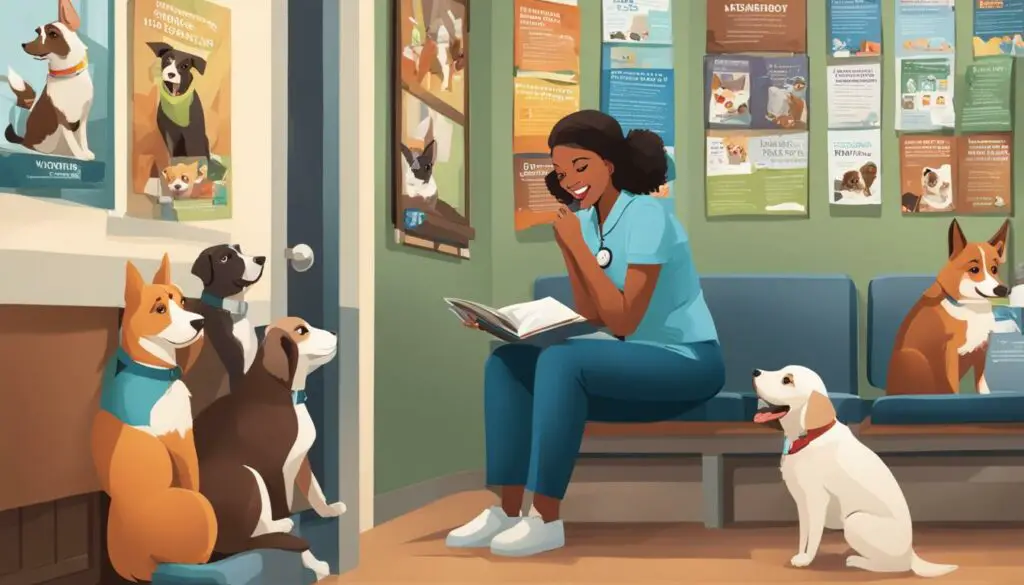
Table: Benefits of Seeking Professional Guidance
| Benefits | Reasons |
|---|---|
| Expert advice | Receive guidance from trained professionals with specialized knowledge about cat urination problems. |
| Tailored treatment plans | Get personalized treatment strategies that address your cat’s specific needs and circumstances. |
| Support throughout the process | Have professionals who understand the emotional challenges of dealing with a cat’s urination issue and provide ongoing support. |
| Access to comprehensive assessments | Receive detailed evaluations of your cat’s behavior to identify underlying causes and develop effective treatment plans. |
| Peace of mind | Gain reassurance knowing that you’re working with experts who have your cat’s best interests at heart. |
Creating a Supportive Environment for a Cat with Urination Issues
When addressing a cat’s urination issues, it’s essential to create a supportive environment that promotes their well-being and encourages healthy litter box habits. By implementing a few simple strategies, you can help your cat feel comfortable and confident using the litter box, reducing the likelihood of urinating outside of it.
1. Provide a Clean and Comfortable Litter Box
The first step in creating a supportive environment is to ensure that your cat has a clean and comfortable litter box. Scoop the litter box daily to remove waste and clumps, and replace the litter regularly to maintain freshness. Choose a litter that your cat prefers and that is easy for them to dig and cover their waste. Additionally, make sure the litter box is large enough for your cat to move around comfortably.
2. Enrich Your Cat’s Environment
Enriching your cat’s environment with toys, scratching posts, and interactive play sessions can help reduce stress and anxiety, which can contribute to urination problems. Provide a variety of toys to keep your cat mentally and physically stimulated, and offer vertical spaces like cat trees or shelves for climbing and perching. Regular playtime and interactive sessions with your cat will also help strengthen the bond between you and provide a positive outlet for their energy.
3. Minimize Stressors
Identify and minimize any stressors in your cat’s environment that may be contributing to their urination issues. Introduce new pets or people gradually, allowing your cat time to adjust to the changes. Create designated safe spaces for your cat where they can retreat and relax without feeling threatened. Additionally, ensure that their litter box is located in a quiet and accessible area, away from loud noises or high-traffic areas of the house.
By creating a supportive environment, you can help your cat feel secure and confident, reducing the likelihood of urination problems. Remember to consult with your veterinarian for additional guidance and support in addressing your cat’s specific needs.
Educating Others about Urination Problems
One of the most important steps we can take in addressing cat urination problems is to raise awareness and educate others about this issue. By sharing our experiences and knowledge, we can help dispel common misconceptions and reduce the stigma surrounding cats who urinate outside the litter box. Through education, we can foster empathy and understanding, promoting a society that supports responsible pet ownership and the well-being of our feline companions.
When discussing cat urination problems, it’s essential to emphasize that this behavior is not intentional or malicious. Cats do not urinate outside the litter box out of spite, but rather as a sign of underlying issues such as stress, anxiety, or medical conditions. By helping others understand these root causes, we can shift the narrative and encourage compassionate responses instead of blame or punishment.
There are several ways we can educate others about cat urination problems. Sharing our stories and insights through social media, blogs, or community forums can reach a wide audience and spark meaningful conversations. Providing practical information on common causes, treatment options, and preventive measures can empower cat owners to seek help and take proactive steps to address the problem. Additionally, collaborating with local animal shelters, veterinary clinics, or rescue organizations to conduct workshops or informational sessions can have a significant impact in raising awareness within the community.
By joining forces and educating others, we can create a supportive network that understands and empathizes with cat urination problems. Together, we can break the silence, overcome the stigma, and ensure that all cats receive the care and understanding they deserve.

The Role of Diet in Urination Issues
When it comes to addressing a cat’s urination issues, the role of diet cannot be overlooked. The food we feed our feline companions plays a crucial role in their overall urinary health. Commercially manufactured cat foods that are biologically inappropriate can lead to unnatural and irritating urine chemistry, causing chronic lower urinary tract irritation and inflammation. This can contribute to a cat’s tendency to urinate outside the litter box.
It’s important to provide cats with a biologically appropriate diet that supports their natural urinary health. This means feeding them a diet that closely mimics what they would eat in the wild. A diet rich in moisture, high-quality protein, and appropriate mineral balance can help maintain a healthy urinary tract and reduce the risk of urination problems.
There are several key factors to consider when choosing a diet for a cat with urination issues. Firstly, ensure that the food is moisture-rich. Cats have a naturally low thirst drive, and being well-hydrated is essential for maintaining urinary health. Wet or canned foods are a great option as they provide a significant amount of moisture and can help prevent urinary issues.

The Impact of Diet on Cat’s Urination Behavior
“Feeding a biologically appropriate diet can help maintain a healthy urinary tract and reduce the risk of urination problems.” – Dr. Jane Smith, Veterinary Nutritionist
Secondly, focus on high-quality protein sources. Cats are obligate carnivores, meaning they require animal-based protein to thrive. A diet rich in high-quality protein can help support overall urinary health and reduce the risk of inflammation and irritation in the urinary tract.
Lastly, pay attention to the mineral balance in the diet. Excessive levels of certain minerals, such as magnesium, can contribute to the formation of urinary crystals or stones. Opting for a diet that is formulated to promote a healthy urinary pH and contains appropriate mineral levels can help prevent these issues.
Consulting with a veterinarian or a veterinary nutritionist can provide further guidance on selecting the most appropriate diet for a cat with urination issues. They can assess the cat’s specific needs and recommend a diet tailored to their unique circumstances. Remember, every cat is different, and finding the right diet can make a significant impact on their urinary health.
Addressing Behavioral Factors in Cat Urination Problems
In addition to medical conditions, behavioral factors can also contribute to cat urination problems. Identifying and addressing these factors is crucial in order to effectively resolve the issue and prevent future incidents.
One common behavioral factor is anxiety or fear associated with the litter box. Cats may develop negative associations with the litter box due to past traumatic experiences or a lack of proper training. This can lead to avoidance behaviors and urination outside the litter box.
To address this, it’s important to create a positive and comfortable environment around the litter box. This can be done by placing the litter box in a quiet and private area, away from loud noises or high traffic areas. Additionally, using a litter box with low sides and easy access can help cats feel more comfortable and secure during elimination.
Implementing behavior modification techniques can also be beneficial in addressing these behavioral factors. This may include desensitization exercises, where the cat is gradually exposed to the litter box and positive reinforcement is used to encourage appropriate behavior. Consulting a veterinary behaviorist can provide expert guidance in developing a tailored behavior modification plan for your cat.
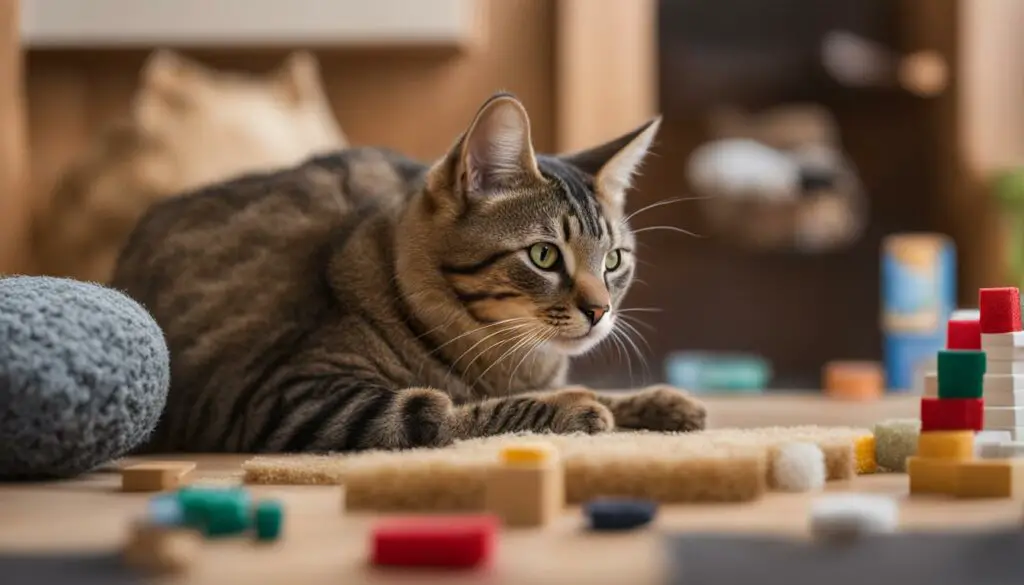
Table: Tips for Addressing Behavioral Factors in Cat Urination Problems
| Tip | Description |
|---|---|
| Create a Positive Environment | Place the litter box in a quiet and private area, away from loud noises or high traffic areas. |
| Use an Appropriate Litter Box | Choose a litter box with low sides and easy access to help cats feel more comfortable and secure during elimination. |
| Implement Behavior Modification Techniques | Work with a veterinary behaviorist to develop a tailored behavior modification plan, including desensitization exercises and positive reinforcement. |
| Provide Enrichment and Play Opportunities | Engage your cat in interactive play sessions and provide environmental enrichment through toys, scratching posts, and puzzle feeders to alleviate stress and boredom. |
| Seek Professional Guidance | If behavioral issues persist, consult a veterinary behaviorist who can provide expert advice and guidance in resolving the problem. |
By addressing behavioral factors and providing a supportive environment, you can help your cat overcome urination problems and ensure their overall well-being.
Preventing Urination Problems in Cats
Preventing urination problems in cats requires proactive measures and a focus on maintaining their urinary health. By implementing these strategies, you can minimize the likelihood of your cat urinating outside the litter box and promote a healthier and happier environment for both you and your feline companion.
Creating the Ideal Litter Box Environment
The litter box is a central factor in preventing urination problems in cats. Ensure you provide an appropriate number of litter boxes for the number of cats in your household. Aim for at least one litter box per cat, plus an additional box, to prevent overcrowding and allow for individual preferences.
- Keep the litter boxes clean: Scoop the litter box daily and change the litter regularly to maintain cleanliness and prevent odor buildup.
- Choose the right litter: Cats have individual preferences for litter type, so experiment with different textures and substrates to find the one your cat prefers.
- Size and placement matter: Ensure the litter box is appropriately sized for your cat, allowing them to comfortably enter, turn around, and dig. Additionally, place litter boxes in quiet, easily accessible areas of the house to minimize stress.
Reducing Environmental Stressors
Stress can contribute to urination problems in cats. Minimizing environmental stressors can help prevent these issues from arising. Consider the following:
- Provide environmental enrichment: Engage your cat with toys, scratching posts, and interactive play to keep them mentally and physically stimulated.
- Reduce changes in the household: Cats are sensitive to changes in their environment. Minimize disruptions by introducing new pets or people gradually and providing safe spaces for your cat to retreat.
Regular Veterinary Check-ups and Diet
Regular veterinary check-ups are essential for monitoring your cat’s overall health, including their urinary system. During these visits, discuss any concerns or changes in your cat’s behavior with your veterinarian.
“Regular veterinary check-ups and open communication with your veterinarian can help ensure your cat’s well-being.”
Additionally, feeding your cat a balanced and biologically appropriate diet plays a crucial role in maintaining urinary health. Consult with your veterinarian to select a diet that supports your cat’s specific needs and promotes healthy urination habits.
By taking a proactive approach and implementing these measures, you can prevent urination problems in cats and provide them with a supportive environment that contributes to their overall well-being.
| Prevention Strategies | Benefits |
|---|---|
| Creating the ideal litter box environment | Minimizes litter box aversion and promotes regular use |
| Reducing environmental stressors | Helps prevent stress-induced urination problems |
| Regular veterinary check-ups and diet | Monitors urinary health and supports overall well-being |
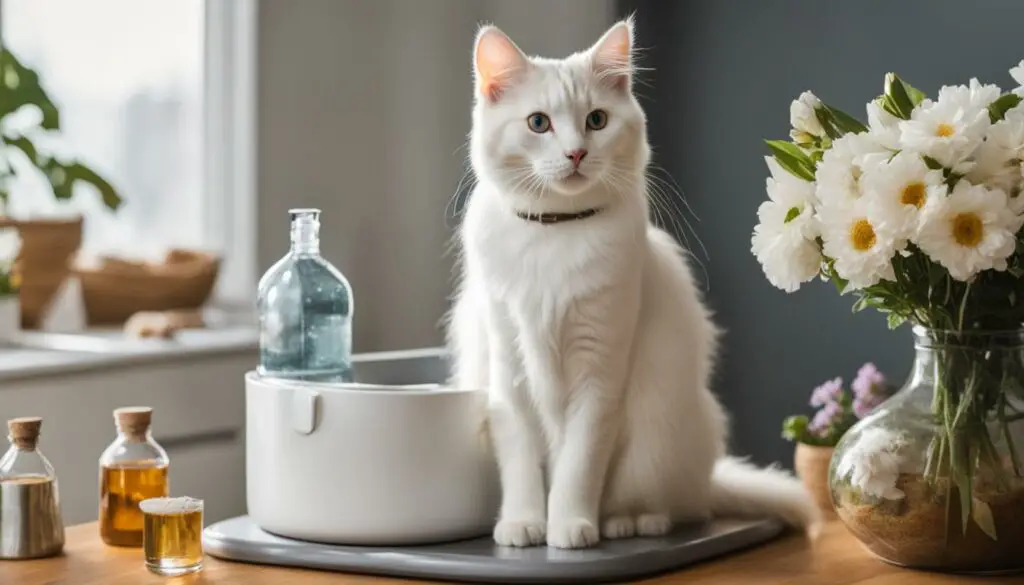
Conclusion
Deciding to euthanize a cat for urinating is a deeply personal and difficult choice. However, it’s essential to exhaust all available treatment options and carefully consider the cat’s quality of life before making this decision. Remember, urinating outside the litter box is often a treatable problem with positive outcomes.
By seeking veterinary guidance, creating a supportive environment, and addressing any underlying medical or behavioral factors, you can find a compassionate and appropriate solution for your cat. Remember, you’re not alone in this process, and there is support available to help you navigate this difficult journey.
If you’re facing this challenging decision, reach out to a veterinarian or a board-certified veterinary behaviorist who can provide expert advice, develop tailored treatment plans, and offer the support you need. Their expertise and empathy can make a significant difference in finding the best outcome for both you and your beloved cat.
Ultimately, prioritizing your cat’s well-being and ensuring a positive and comfortable life should guide your decision-making process. Remember the love and joy your cat has brought into your life, and cherish the memories you shared. You are doing your best to make the right choice for your furry friend.
FAQ
Why do cats urinate outside of the litter box?
Cats may urinate outside of the litter box due to various reasons, including social stress, environmental stress, medical illnesses, and anxiety or fear related to the litter box.
How can I address my cat’s urination problem?
You can address your cat’s urination problem by increasing the number of litter boxes, cleaning the litter box daily, ensuring the litter box is appropriately sized, spreading litter boxes throughout the house, and seeking veterinary help to explore treatment options.
Why is medical evaluation important for a cat with urination issues?
Medical conditions such as kidney disease, urinary tract infections, and certain medications can significantly impact a cat’s urination behavior. Identifying and treating these underlying medical issues is essential for addressing the problem effectively.
What factors should I consider before euthanizing a cat for urinating?
Factors to consider before euthanasia may include the severity and duration of the urination problem, the cat’s response to treatment, the impact on the cat’s overall well-being, and the emotional and financial resources available to address the issue.
Can you explain the euthanasia process for cats?
The euthanasia process involves making the cat as comfortable as possible and administering a euthanasia solution, usually a barbiturate. The solution induces loss of consciousness, pain sensation, and eventually stops the heart and lungs. The procedure is quick and painless for the cat.
Should I be present during my cat’s euthanasia?
Whether or not to be present during euthanasia is a personal decision for the owner and should be based on what they feel would be most comforting for both themselves and their pet.
What are the aftercare options for a euthanized cat?
Aftercare options for a euthanized cat may include cremation, burial, communal cremation, or leaving the remains with the veterinarian for appropriate disposal. It’s important to discuss the available options with your veterinarian and choose the one that feels most comforting for you and respects your cat’s memory.
How can I cope with the loss of my cat?
It’s important to give yourself time and space to grieve. Reach out to friends, family, or support groups who can provide understanding and empathy during this difficult time. Remember that everyone grieves differently, and it’s okay to seek professional help if needed. Memorializing your cat and cherishing the memories you shared can also be a healing process.
Where can I seek professional guidance for my cat’s urination problem?
Veterinarians and board-certified veterinary behaviorists can provide expert advice, develop tailored treatment plans, and offer support throughout the process. Their expertise and empathy can make a significant difference in finding a compassionate and appropriate solution for your cat.
How can I create a supportive environment for a cat with urination issues?
Providing a clean and comfortable litter box, enriching the cat’s environment with toys and scratching posts, and minimizing stressors such as introducing new pets or people into the household can contribute to creating a supportive environment for a cat with urination issues.
How can I raise awareness about cat urination problems?
By sharing your experience and educating others about cat urination problems, you can help raise awareness and reduce the stigma surrounding this issue. Spreading knowledge and empathy can contribute to a society that understands and supports responsible pet ownership, promoting happier and healthier lives for cats.
What is the role of diet in a cat’s urination behavior?
Commercially manufactured cat foods that are biologically inappropriate can lead to unnatural, irritating urine chemistry, causing chronic lower urinary tract irritation and inflammation. It’s important to feed cats a biologically appropriate diet that supports their natural urinary health.
How can I address behavioral factors in my cat’s urination problems?
Working with a veterinary behaviorist or implementing behavior modification techniques can help address behavioral factors and create a more positive association with the litter box for the cat.
How can I prevent urination problems in my cat?
Taking proactive measures such as providing an appropriate number of litter boxes, keeping them clean, using suitable litter, addressing any environmental stressors, and regular veterinary check-ups can help prevent urination problems in cats.

